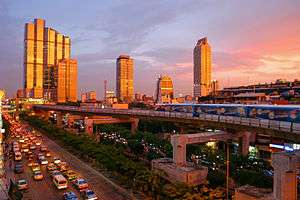Urban ecosystem
Urban ecosystems are the cities, towns, and urban strips constructed by humans.
This is the growth in the urban population and the supporting built infrastructure has affected both urban environments and also on areas which surround urban areas. These include semi or 'peri-urban' environments that fringe cities as well as agricultural and natural landscapes.
Scientists are now developing ways to measure and understand the effects of urbanization on human and environmental health.[1]
By considering urban areas as part of a broader social-ecological system,[2] scientists can investigate how urban landscapes function and how they affect other landscapes with which they interact. In this context, urban environments are affected by their surrounding environment but also affect that environment. Knowing this may provide clues as to which alternative development options will lead to the best overall environmental outcome.
CSE's urban ecosystem research is focused on:
- Understanding how cities work as integrated social-ecological systems
- Developing sustainable approaches to development of city fringe areas that reduce negative impact on surrounding environments
- Developing approaches to urban design that provide for health and opportunity for citizens.
Current Research
- Urban Systems - research developing new technologies and providing integrated infrastructure solutions to reduce Australia’s urban ecological footprint and increase infrastructure effectiveness.
- Creating urban sustainability - (CSIRO.au Web site) CSIRO is applying its technological expertise to help Australia improve the sustainability of its cities.
- Urban Ecological Commission - a foundation dedicated to raising public awareness about the flora and fauna of big-city America
- TwinCam Futures - a new and innovative research partnership that will build regional capacity in Campbelltown and Camden for exploring the opportunities and risks of a range of possible future development pathway
Bibliography
- Gibson, R.B., Alexander, D.H.M., & Tomalty, R. (1997). "Putting cities in their place: Ecosystem-based planning for Canadian urban regions." In M. Roseland (Ed.), Eco-city dimensions: Healthy communities, healthy planet (pp. 25-39). Gabriola Island, B.C.: New Society. Retrieved: http://hdl.handle.net/10613/2758
- Manfredi Nicoletti, L'Ecosistema Urbano (The Urban Ecosystem), Dedalo Bari 1978
